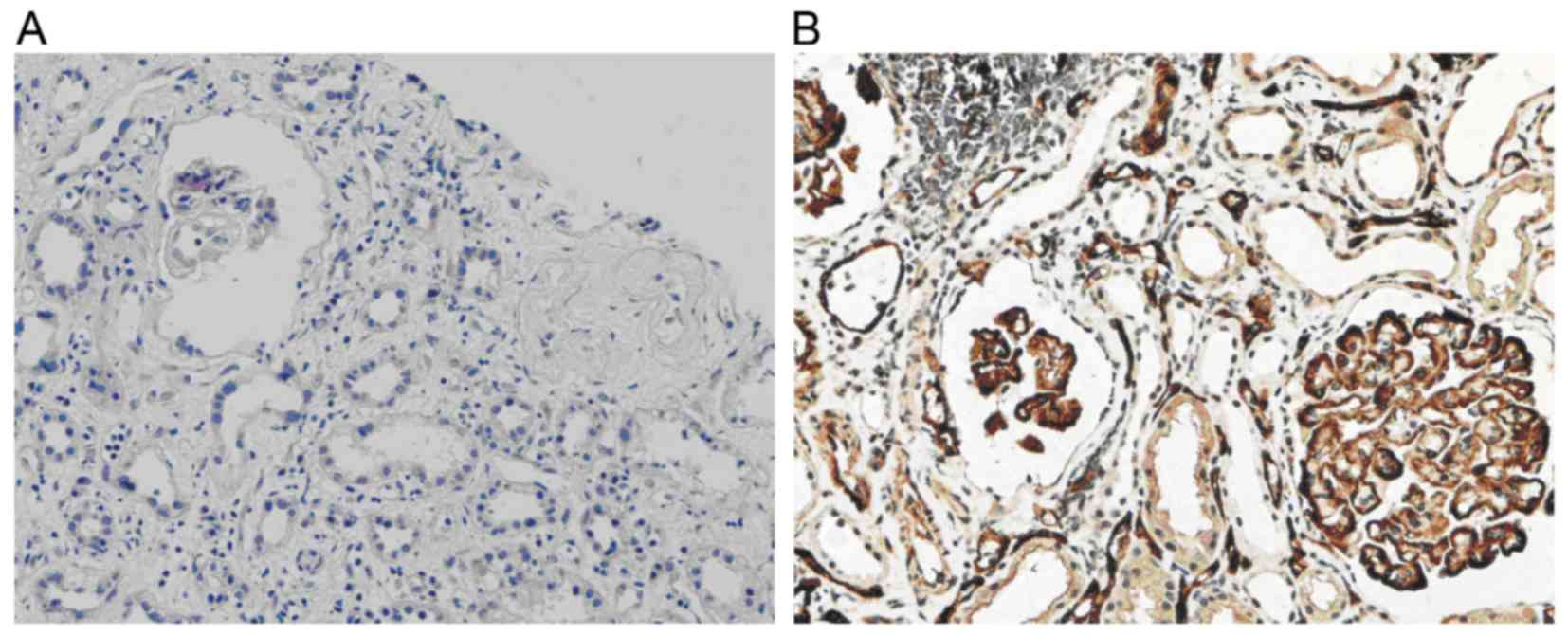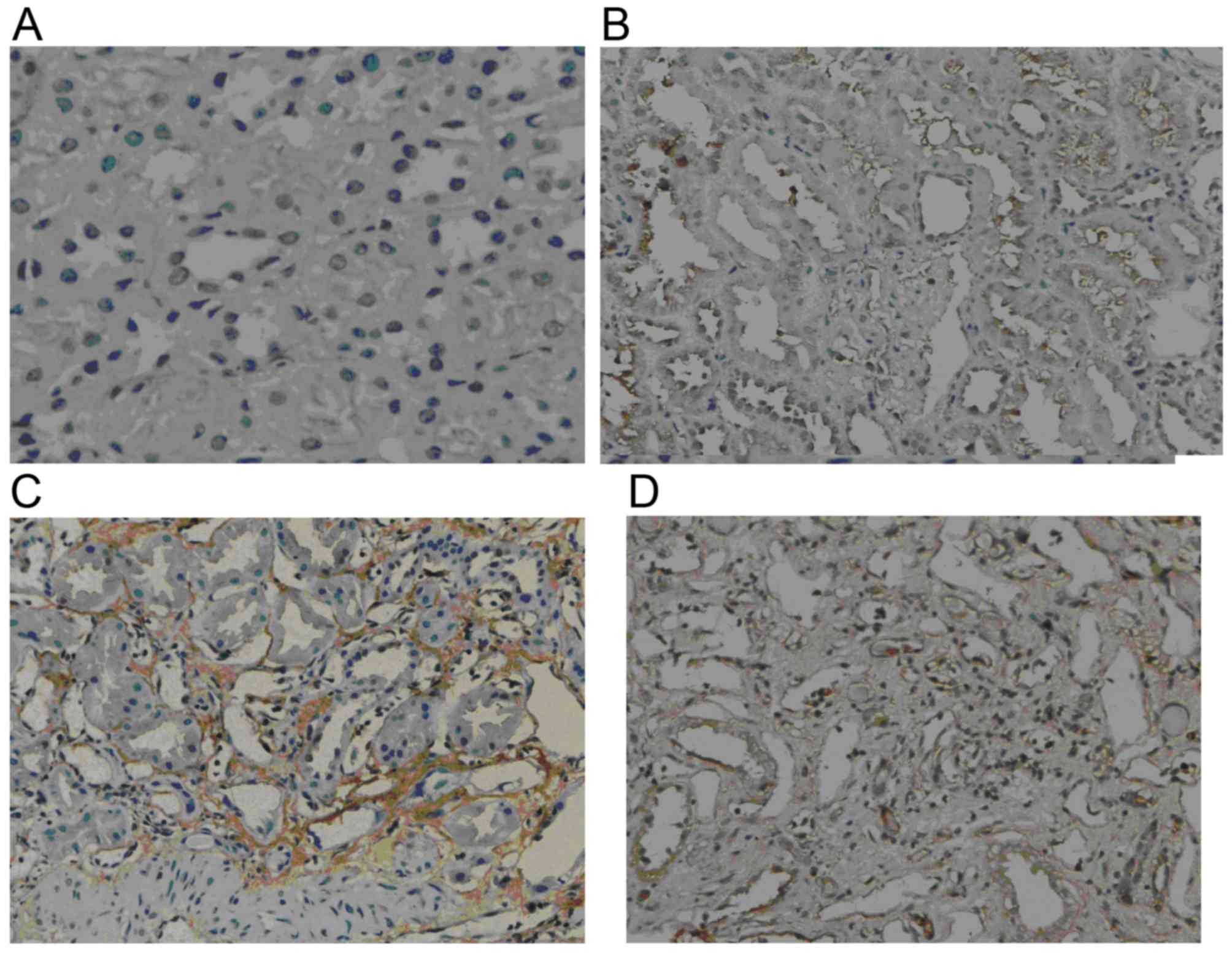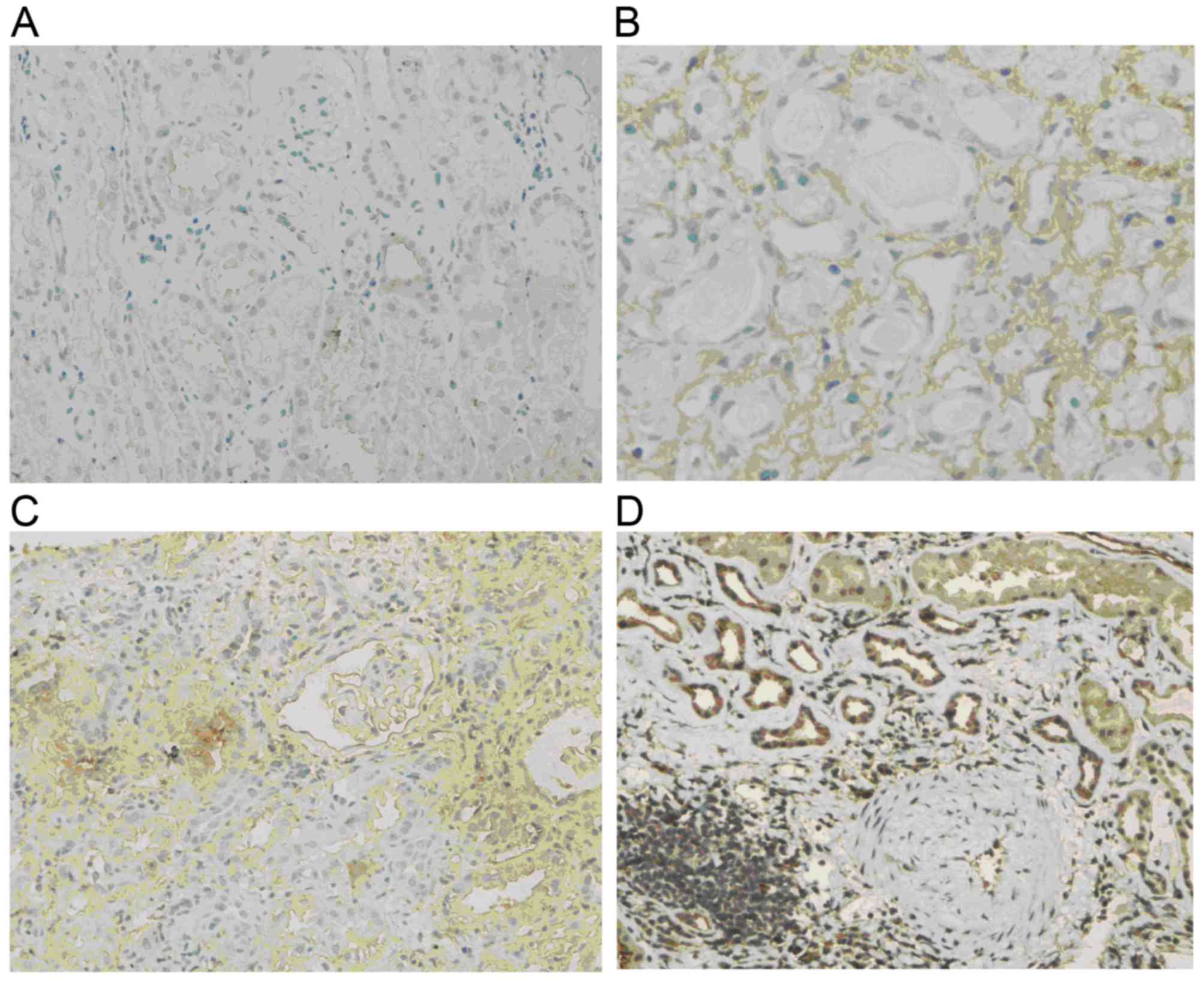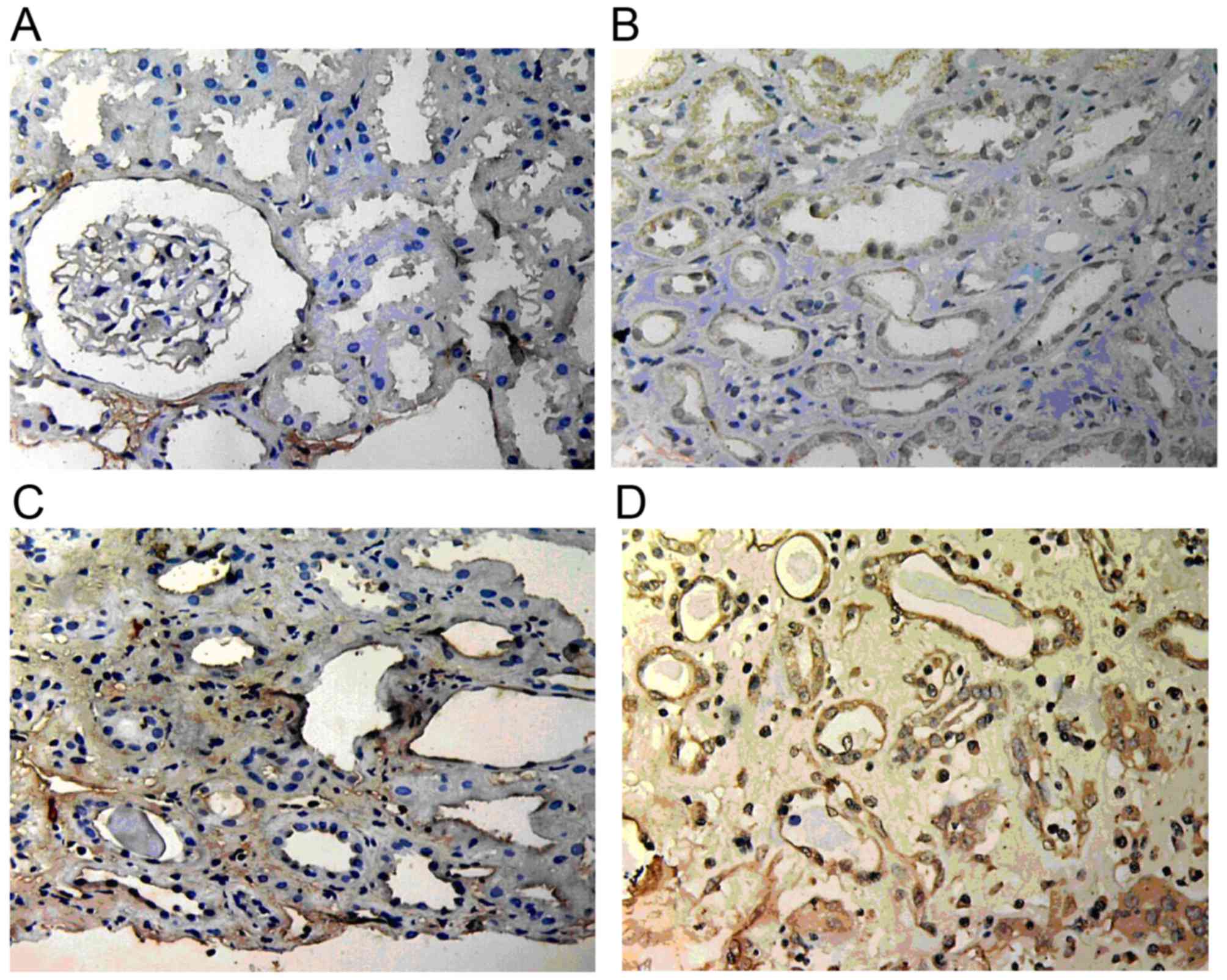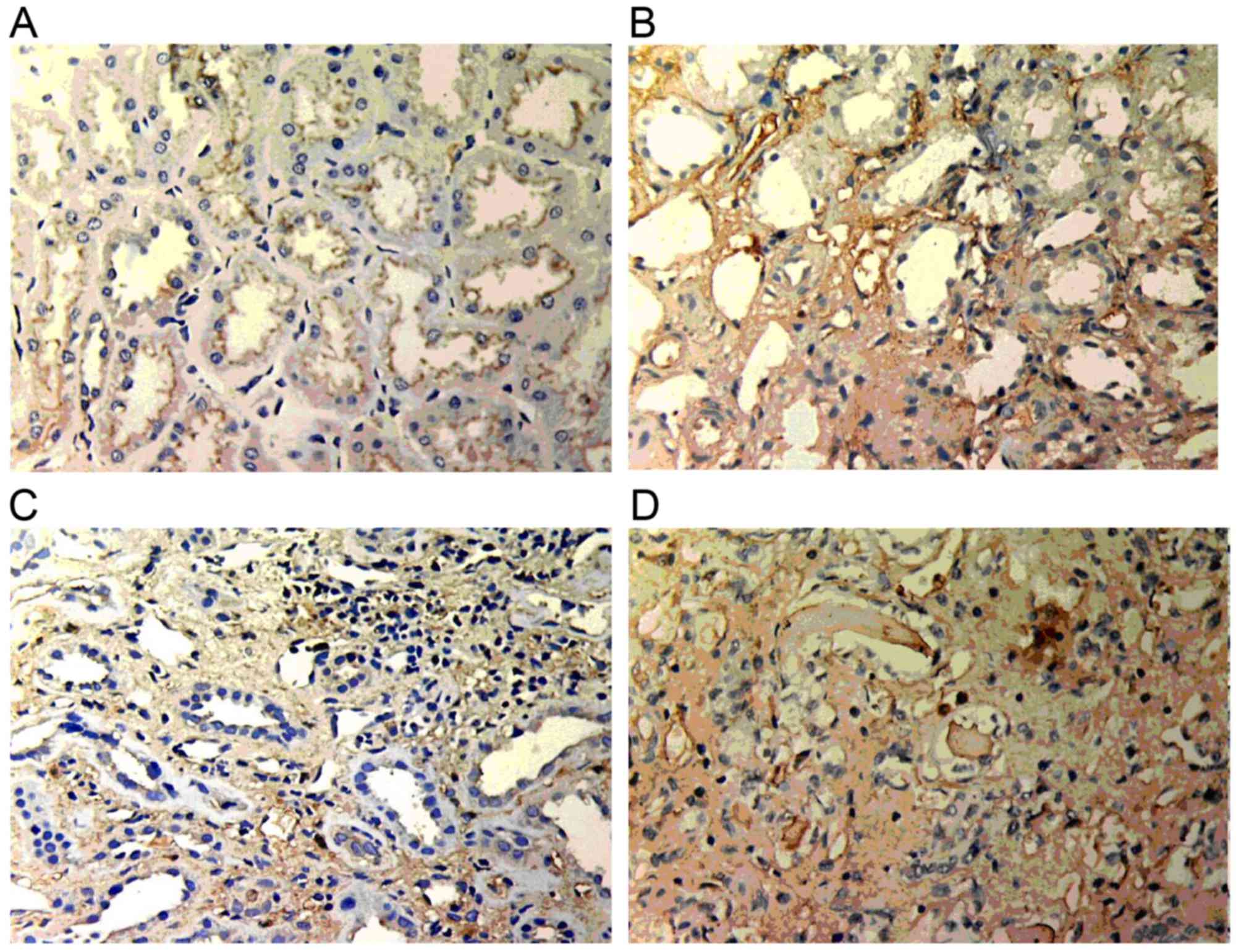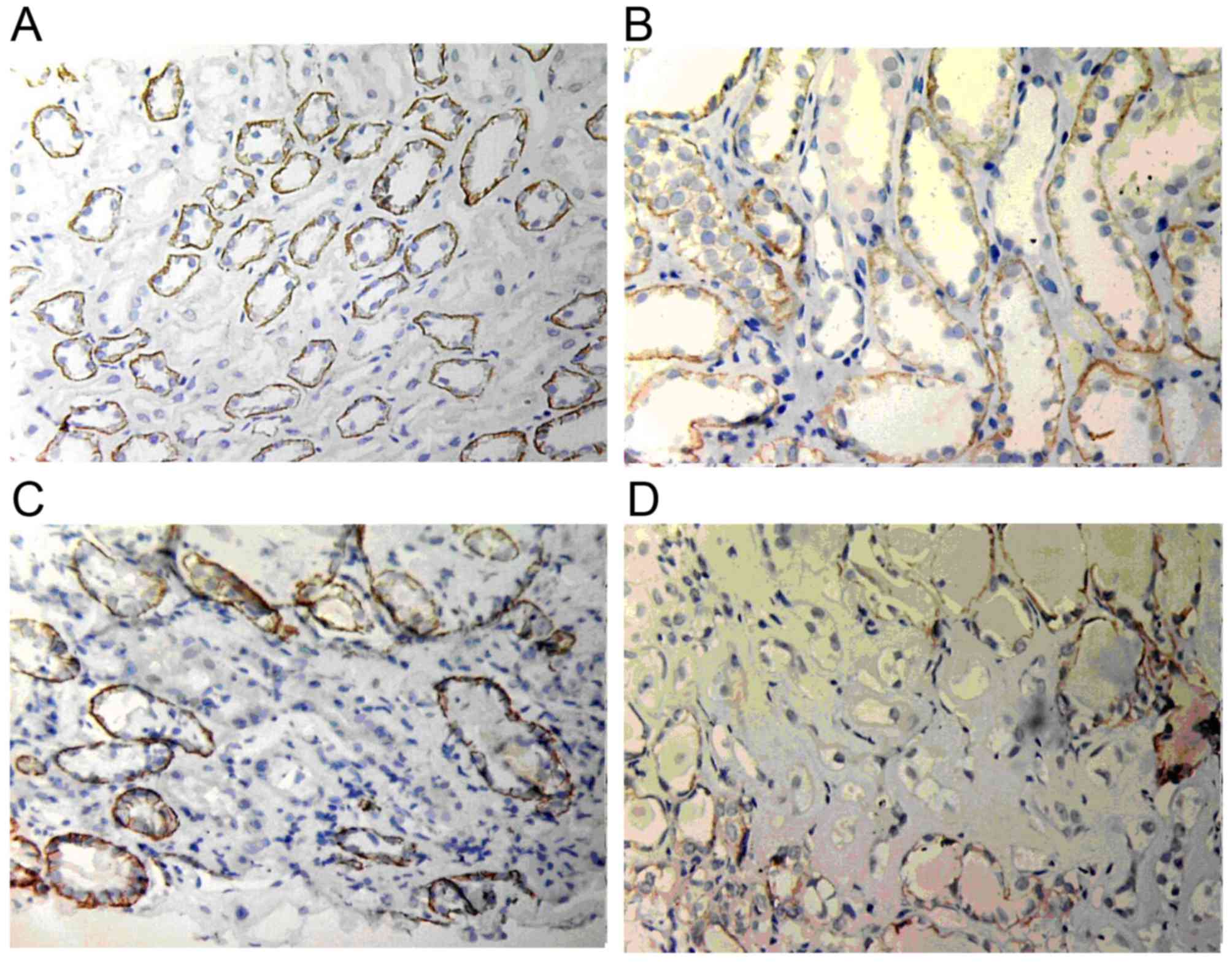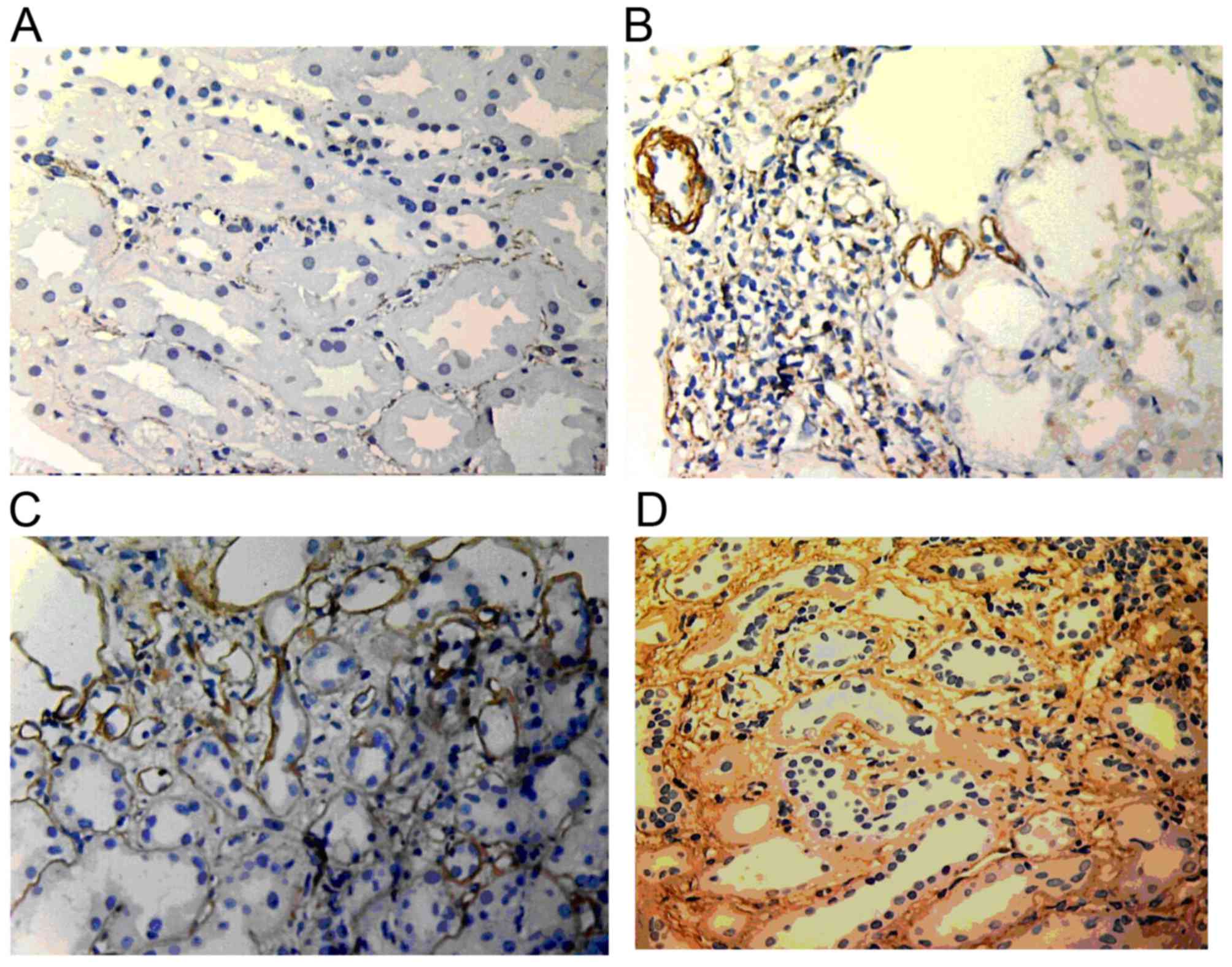Correlation between PKB/Akt, GSK‑3β expression and tubular epithelial‑mesenchymal transition in renal allografts with chronic active antibody‑mediated rejection
- Authors:
- Published online on: March 24, 2017 https://doi.org/10.3892/etm.2017.4261
- Pages: 2217-2224
-
Copyright: © Yan et al. This is an open access article distributed under the terms of Creative Commons Attribution License.
Abstract
Introduction
Chronic renal allograft dysfunction (CRAD), defined as an irreversible decline of renal allograft function, is one of the main factors reducing long-term survival of renal allograft tissue (1–3). At present, chronic active antibody-mediated rejection (ABMR) is generally considered as an inducing factor contributing to CRAD. The pathological mechanism of CRAD can be expressed as interstitial fibrosis and tubular atrophy (IF/TA), which is closely related to the decline of renal allograft function. In addition, epithelial-mesenchymal transdifferentiation (EMT) has an important role in the process of interstitial fibrosis (4). Studies on animal models and in vitro experiments have shown that the EMT participates in the progression of interstitial fibrosis in renal allografts with CRAD. It has been indicated that integrin-linked kinase (ILK) and transforming growth factor (TGF)-β1 are the key factors inducing EMT (5). Furthermore, a previous study by our group identified a positive correlation between the expression of ILK and the development of CRAD (6). However, to date, no study has assessed the roles of Akt (also known as protein kinase B) and glycogen synthase kinase (GSK)-3β in the development of EMT in renal allografts with ABMR. Therefore, immunohistochemical staining and semi-quantitative methods were applied in the present study to assess the levels of phosphorylated (p)-Akt, GSK-3β, TGF-β1, ILK, E-cadherin and α-smooth muscle actin (SMA). The results suggested that the Akt/GSK-3β signaling pathway is involved in the development of EMT induced by TGF-β1 and ILK in human renal allografts with ABMR, and therefore participates in the pathogenesis of IF/TA inducing ABMR.
Materials and methods
Patients and samples
Samples were collected from 38 renal transplant recipients who were pathologically diagnosed with chronic active ABMR. Renal allograft biopsy was performed in all of the recipients due to upward-creeping serum creatinine or resistant proteinuria from June 2010 to January 2012. The diagnosis of chronic ABMR was made according to the Banff 2009 classification (7,8). Among the 38 cases of ABMR, 22 were male (age, 44±9 years) 16 were female (age, 40±9 years). The duration after kidney transplantation was 1–9 years (mean, 4 years). For the immunosuppressant protocols, 20 recipients received cyclosporine + mycophenolate mofetil + prednisone therapy, 17 received tacrolimus + mycophenolate mofetil + prednisone therapy and one recipient received sirolimus + mycophenolate mofetil + prednisone therapy. Prior to renal biopsy, all of the renal allografts were detected by color ultrasound and the blood drug concentration was determined to further exclude acute rejection, calcineurin inhibitor renal toxicity, ureteral obstruction/regurgitation and other renal diseases. All of the recipients had matching blood groups to donors and two or more loci matching with regard to human leukocyte antigen (HLA)-A, HLA-B and HLA-DR antigens. The results of the lymphocytotoxicity test were <10% crossmatch (negative) and panel reactive antibody scores were <10%. Nine specimens of renal tissue used in the present study came from nine normal donor kidneys from healthy donors, verified by pre-transplant biopsy and clinical follow-up of the recipients.
Histological examination
The paraffin-embedded kidney specimens were cut into 3-µm tissue sections that were de-paraffinized with xylene and hydrated with a graded series of ethanols (100, 96, 90 and 70%) and distilled water. Staining was performed according to standard histology procedures, including hematoxylin/eosin stain, periodic-acid schiff stain, masson trichrome and periodic schiff-methenamine stain. The slides were observed under a microscope in a blinded manner for inflammatory-cell infiltration in renal tissue, increased mesangial and extracellular matrix, proliferation of mesangial cells, epithelium and endothelium, adhesions and sclerosis, thickening of glomerular basement membranes and double track sign, thickening of peritubular capillary basement membrane, interstitial fibrosis, inflammatory cell infiltration, tubular atrophy and intimal thickening of arteries.
Immunohistochemical staining
The EnVision method was used for immunohistochemical staining. Paraffin sections (3-µm thickness) received routine baking and were dewaxed with xylene and rehydrated with a series of graded ethanols. 3% hydrogen peroxide was adopted to clear endogenous hydrogen peroxidase. Prior to immunohistochemial staining, antigen retrieval was performed in sodium citrate buffer in a microwave (550 watts) for 15 min for the analysis p-Akt and GSK-3β and for 3×3 min for all other proteins apart from α-SMA, for which no antigen retrieval was required. Samples were then incubated with rabbit anti-human polyclonal p-Akt antibody (cat. no. 9611S; 1:300 dilution; Cell Signaling Technology, Inc., Danvers, MA, USA), rabbit anti-human polyclonal GSK-3β antibody (cat. no. BA-0906; 1:100 dilution; Wuhan Boshide Co., Wuhan, China), mouse anti-human monoclonal ILK antibody (cat. no. SC-20019; 1:200 dilution; Santa Cruz Biotechnology, Inc., Dallas, TX, USA), rabbit anti-human TGF-β1 antibody (cat. no. RAB-0238; working solution; Fuzhou Maixin Co.), mouse anti-human E-cadherin antibody (cat. no. MAB-0589; working solution; Fuzhou Maixin Co.) or mouse anti-human α-SMA antibody (cat. no. MAB-0003; working solution; Fuzhou Maixin Co.) overnight at 4°C. After washing with PBS, anti-rabbit (cat. no. KIT-9902; Fuzhou Maixin Co.) was added and the sections were incubated for 30 min at 37°C. Subsequent to washing with PBS, antibodies were visualized with diaminobenzidine and counterstained with hematoxylin prior to microscopic observation.
Staining was considered positive when pale yellow, brownish yellow and yellowish-brown particles occurred in tissue. Immunohistochemical staining in each group was compared with that in a control group with PBS as a substitute for the primary antibody. At the same time, the deposition of immunoglobulin (Ig)A, IgG, IgM, C3, C4, C1q and C4d were routinely tested for renal biopsy.
Pathological classification
According to the Banff 2009 classification (7) the pathological manifestation of renal allografts with ABMR can be classified as: i) C4d positive, coexistence of circulating anti-donor antibodies; ii) IF/TA and thickening of the glomerular basement membrane. The severity grade of IF/TA was divided into three groups: IF/TA-I, mild IF/TA (<25% cortex involved); IF/TA-II, moderate IF/TA (26–50% cortex involved) and IF/TA-III, severe IF/TA (>50% cortex involved), which may include nonspecific sclerosis of blood vessels and glomeruli, but is certainly accompanied by tubular interstitial lesion.
Semiquantitative analysis
Semiquantitative analysis was performed with a DMR+Q550 renal color patho-image analysis system (Leica, Wetzlar, Germany). 10 discontinuous tubulointerstitial fields (magnification, ×400; excluding glomeruli, veins and arteries) were randomly selected in different regions including renal cortex, cortex-medulla juncture and medullary interstitium. More than 60 tubules were involved in each part. Positive results were indicated by yellow-stained cells. ImagePro Plus software version 6.0.0.260 (Media Cybernetics, Rockville, MD, USA) was utilized to determine the ratio of the positive to total area (area of tubular lumens excluded). The relative amount of each type of protein in the renal tubulointerstitium was represented as the mean value.
Statistical analysis
All experimental data were expressed as the mean ± standard deviation. SPSS 13.0 statistical software (SPSS, Inc., Chicago, IL, USA) was adopted for data analysis. Differences in the levels of p-AKT, GSK-3β, ILK, TGF-β1, E-cadherin and α-SMA were analyzed by single-factor analysis of variance. Pearson's linear correlation analysis was used for two-variable correlation. P<0.05 was considered to indicate a statistically significant difference.
Results
Histological examination
By observation under the light microscope, the pathological manifestations of ABMR in renal allografts of the recipients were identified to include focal interstitial diffuse fibrosis, different degrees of tubular atrophy and disordered arrangements, accompanied by plasma cell and lymphocyte invasion (Fig. 1A).
Grouping based on IF/TA grades
According to the Banff 2009 classification, recipients diagnosed with ABMR were divided into three groups: Group IF/TA-I (12 cases), IF/TA-II (14 cases) and IF/TA-III (12 cases), based on the grade of IF/TA (I, II or III).
C4d deposition
In normal renal tissue, C4d deposition is present in the glomerular mesangium and segmental endarterium, while it is rarely shown in glomerular and peritubular capillaries. However, in the renal allograft tissue with chronic active ABMR, diffuse and linear deposition of C4d was obvious in endothelial cells of peritubular capillaries (Fig. 1B).
GSK-3β expression
Weak GSK-3β expression was present in normal renal tissue. However, in the renal allograft tissue with chronic active ABMR, GSK-3β expression was markedly increased. The expression was mainly located in the endochylema of tubular cells and was enhanced with increasing IF/TA pathological grade (Fig. 2).
p-Akt levels
Normal renal tissue was almost negative for p-Akt. In comparison, p-Akt was obviously increased in renal allograft tissue with chronic active ABMR. The expression was mostly located in the endochylema of tubular epithelial cells and interstitial cells and tended to be enhanced with increases in the IF/TA grade (Fig. 3).
ILK expression
ILK expression in normal renal tissue was low or absent; however, it was markedly increased in renal allograft tissue with ABMR and was mainly located in the endochylema of tubular epithelial cells and interstitial cells. Atrophic renal tubules showed the highest ILK staining. With the increase of the pathological grade of IF/TA, ILK expression became stronger and its scope became wider (Fig. 4).
TGF-β1 expression
TGF-β1 expression in normal renal tissue was mainly located in the endochylema of tubular epithelial cells and was weakly positive. In renal allograft tissue, TGF-β1 expression in tubular epithelial cells, interstitial cells and the interstitial matrix area was in positive. Moreover, the expression was increased in the IF/TA-I group and showed further increases in the IF/TA-II and IF/TA-III groups (Fig. 5).
E-cadherin expression
In normal renal tissues, E-cadherin expression was mainly located in the basement membrane of glomeruli and tubular epithelial cells but not in the endochylema of tubular cells. However, in renal allograft tissue with ABMR and IF/TA grade I, E-cadherin expression started to reduce. In addition, in the IF/TA grade II group, E-cadherin expression was markedly reduced and only few cells expressed E-cadherin in the IF/TA grade III group (Fig. 6).
α-SMA expression
In normal renal tissue, α-SMA was only expressed in the muscle layer of vascular smooth muscle and randomly expressed in the renal interstitium. In renal allografts with ABMR, the expression increased along with the increase of the IF/TA grade. α-SMA expression was widely distributed in the renal interstitium. Furthermore, α-SMA expression was also found in renal tubules with lumen damage and tubular atrophy (Fig. 7).
Association between the levels of p-Akt, GSK-3β, ILK, TGF-β, α-SMA and the IF/TA grade
Along with the increase of the IF/TA grade, the levels of p-Akt, GSK-3β, ILK, TGF-β1 and α-SMA in renal allografts with ABMR were obviously increased compared to those in normal renal tissue (P<0.001). By contrast, E-cadherin was significantly reduced (P<0.001) (Table I).
Table I.Positive area ratio of p-Akt, GSK-3β, ILK, TGF-β1, E-cadherin and α-SMA in the renal tubules and tubulointerstitium of normal controls and renal transplant recipients with antibody-mediated rejection. |
Correlation among the expression of p-Akt, GSK-3β, ILK, TGF-β and α-SMA
Linear correlation analysis showed that the expression of p-Akt was positively correlated with ILK, TGF-β and α-SMA (r=0.871, 0.912 and 0.878, respectively; P<0.001). The expression of GSK-3β was also positively correlated with p-Akt, ILK, TGF-β1 and α-SMA (r=0.828, 0.793, 0.874 and 0.781 respectively; P<0.001). However, the expression of p-Akt and GSK-3β was negatively correlated with E-cadherin expression (r=−0.849 and −0.781; P<0.001).
Discussion
CRAD is the main factor affecting the long-term survival of renal allografts and its pathological manifestation is interstitial fibrosis and tubular atrophy. Factors leading to chronic renal allograft dysfunction can be divided into immune factors and non-immune factors, and chronic active ABMR is the main immune factor contributing to CRAD (8). However, the pathogenesis of tubular EMT caused by ABMR has remained to be fully elucidated. Consequently, it is of great significance to investigate the pathogenesis of EMT in renal allograft recipients undergoing ABMR.
EMT is a key factor leading to interstitial fibrosis. It refers to a process by which epithelial cells lose their phenotype under pathogenesis and transdifferentiate into the phenotype of mesenchymal cells. E-cadherin has an important role in maintaining epithelial cell polarity and function. The loss of its expression and the damage of epithelial integrity are the early events in the EMT process of tubular epithelial cells. α-SMA is a marker protein of myofibroblasts. It is not expressed in normal renal tissue but in renal allografts with CRAD. The EMT can be stimulated by various inflammatory factors and cell factors, leading to the transformation of epithelial cells into myofibroblasts and expression of α-SMA. Therefore, α-SMA is a marker of the EMT, which occurs once α-SMA is expressed (9). The EMT is involved in the pathogenesis ABMR and associated mechanisms may offer approaches for preventing CRAD.
In the present study, p-Akt and GSK-3β were present at low levels in normal renal tissue and were markedly increased along with the aggravation of IF/TA, the major pathological manifestation of ABMR. The present study also showed that p-Akt, GSK-3β, TGF and ILK were positively correlated with α-SMA expression but negatively correlated with E-cadherin expression, suggesting that all of these factors participate in the EMT process associated with ABMR leading to the development of CRAD.
TGF-β1, as the most important factor causing renal interstitial fibrosis, is the only cell factor that induces and maintains the EMT process in renal tubules. It has been suggested that the effect of TGF-β1 to induce renal interstitial fibrosis may be accomplished by inducing EMT (10). Furthermore, ILK has been suggested to be an important downstream factor of TGF-β1. Through interacting with integrin b1 and b3, ILK can participate in various transduction pathways of cell signals, including Akt and GSK-3β, and has a significant role in adjusting cellular adhesion, apoptosis, growth and removal as well as extracellular matrix accumulation, and is closely associated with renal disease progression. Furthermore, TGF-β1 expression in tubular epithelial cells is induced by ILK and the expression of these two factors is inter-dependent with regard to time and dosage (11). A study using a rat kidney transplantation model showed that ILK is correlated with tubular interstitial fibrosis and mononuclear cell invasion (12). Li et al (5) suggested the existence of the TGF-β1/Smad/ILK/EMT axis, in which TGF-β1 induces ILK to be expressed in tubular epithelial cells by means of Smad signaling, and if transduction pathways were restrained, ILK expression and the EMT process induced by TGF-β1 were effectively prevented. However, by restraining other transduction pathways downstream of TGF-β1, ILK expression and the EMT process were not completely inhibited. Therefore, ILK markedly influences the EMT process (13).
The results of a previous study by our group suggested the trend that the expression of TGF-β1 and ILK in allograft recipients with ABMR was markedly increased along with the aggravation of the pathological grade of IF/TA (6). In the present study, the expression of ILK in the ABMR group was found to be positively correlated with that of TGF-β1 and α-SMA, while being negatively correlated with that of E-cadherin, which indicates that ILK affects the EMT process of renal allograft tissue and furthermore triggers tubular interstitial fibrosis.
Akt is a serine/threonine kinase with a relative molecular weight of 57 kDa and participates in important cellular signal transduction pathways. Numerous growth factors and mouse eotaxins have been found to take effect through the Akt signaling pathway. Akt can be activated by the phosphorylation of its ser473 residue and take part in cellular growth, differentiation and apoptotic processes. Subsequent to Akt activation, TGF-β1 and ILK are activated and have a role in stimulating cellular growth and reducing apoptosis (14,15). p-Akt is also a key factor in the EMT process (16). A study on EMT in type II diabetes-associated renal disease in rats showed that TGF-β1 was able to activate Akt and that the activation level of Akt was positively correlated with TGF-β1 expression (14). In the kidney under chronic hypoxia caused by biliverdin, the EMT process can also be induced though the Akt signaling pathway (17). A study on tumor progression found that ILK stimulates the EMT process of tumor cells via Akt (18). Subsequent to activation, Akt stimulates nuclear factor Snail and inhibits the expression of cell adhesion molecule E-cadherin. Thus, the activation of Akt lays a solid foundation for the EMT process (19).
The present study showed that in renal allograft tissues, the expression of Akt increased along with the aggravation of the pathological grade of IF/TA and that there was a positive correlation between the levels of p-Akt and the individual expression of TGF-β1, ILK and α-SMA, while there was a negative correlation between p-Akt and E-cadherin, indicating that Akt takes part in the EMT process associated with ABMR resulting in CRAD. The results of the present study suggested that Akt signal transduction is necessary in the EMT process induced by TGF-β1 and ILK in human renal allografts with ABMR, and that the induction of the EMT process by Akt may proceed via the TGF-β1/ILK signaling pathway.
In studies on diseases rather than kidney transplants, p-Akt was shown to influence the downstream signaling molecule GSK-3β. GSK-3β is a serine/threonine kinase, which is commonly expressed in eukaryotic organisms. GSK-3β is mainly expressed in the nucleus and affects the activation status of downstream molecules via phosphorylation. Besides, GSK-3β is an important substrate of p-Akt. Phosphorylation of Akt deactivates GSK-3β and studies have shown that GSK-3β, as a major component of the Akt pathway, has a role in the EMT process (14).
Gong et al (20,21) have verified that GSK-3β controls the inflammatory reaction in allografts undergoing CRAD and showed that GSK-3β was highly expressed in damaged renal tubules. Increased levels of deactivated p-GSK-3β were negatively correlated with interstitial fibrosis and tubular atrophy. Akt and ILK can trigger the activation of nuclear transcription factor β-catenin and activator protein (AP)-1 by GSK-3β, which makes them enter the nucleus, activate nuclear transcription processes, causes the reduction of epithelial cell adhesion, increases the synthesis of matrix metalloproteinase (MMP)-9 and α-SMA and finally affects the induction and progression of the EMT process (22,23). In a rat model of diabetes-associated renal disease, it was found that the inhibition of the GSK-3β signaling pathway promotes the EMT process induced by high glucose and delays the pathological change of interstitial fibrosis (24). In addition, ILK can also lead to the enhancement of AP-1 and β-catenin activation and the multiplication of cells by phosphorylating and thereby deactivating GSK-3β (25,26). Enhancement of AP-1 leads to increased expression and secretion of MMP-2, breaks the integrity of the glomerular basement membrane, increases the invasion of cells and stimulates the transformation of epithelial cells in the basement membrane to cause interstitial fibrosis (27). Through the nuclear factor (NF)-κB signaling pathway, GSK-3β can also influence the emergence of inflammatory factors and take part in the inflammation reaction, as the EMT process is triggered in renal tubules after NF-κB activates mononuclear cells (28). Studies on tubular epithelial cells have found found that inhibition of GSK-3β phosphorylation may restrain the activation of NF-κB p65 and consequently prevent the expression of inflammatory factors and the emergence of the inflammatory reaction (20,21).
In a previous study by our group, it was demonstrated that in renal allograft tissue, the expression of GSK-3β increases with the aggravation of the pathological grade of IF/TA (29). Furthermore, in the present study, the expression of GSK-3β was found to be positively correlated with the individual levels of ILK, p-Akt and α-SMA in renal allografts with ABMR, which indicated that GSK-3β participates in the EMT process induced by ILK. However, the necessity of Akt to induce ABMR also indicates the possible connection point between ILK and GSK-3β. Based on the results of the present study, it is suggested that tubular fibrosis may be blocked by interference with Akt/GSK-3β signaling.
TGF-β1 stimulates the phosphorylation of Akt and helps LY294002, an inhibitor of the phosphoinositide-3 kinase/Akt pathway, to effectively reduce the expression of collagen I induced by TGF-β1 (30). The GSK-3β inhibitor lithium oxide improved the restoration of renal tissue and damaged epithelial cells through Wnt signaling (31). Troglitazone may improve tubular EMT caused by high glucose in experimental models (22).
Based on the results of previous studies by our and other groups as well as the present study, it is summarized that in renal allograft tissue undergoing ABMR resulting in CRAD, ILK, together with the downstream signaling molecules Akt and GSK-3β, may take part in EMT and interstitial fibrotic processes induced by TGF-β1. As a key mediator, ILK connects the upstream TGF-β1 with the downstream factors Akt and GSK-3β. It is suggested that early detection of ILK, Akt and GSK-3β expression in renal allograft tissues provides a basis for clinical intervention by means of inhibiting the expression or activity of the above factors, which may represent a novel strategy to extend the survival of renal allograft tissues.
Acknowledgements
The project was supported by the Natural Science Foundation of Guangxi (no. 2014GXNSFAA118179), self-funded research projects of Guangxi Health Department (no. Z2014533) and the Science and Technology Planning Project of Guilin (no. 20130121-6).
References
|
Maluf DG, Mas VR, Archer KJ, Yanek K, Gibney EM, King AL, Cotterell A, Fisher RA and Posner MP: Molecular pathways involved in loss of kidney graft function with tubular atrophy and interstitial fibrosis. Mol Med. 14:276–285. 2008. View Article : Google Scholar : PubMed/NCBI | |
|
Chapman J: Addressing the challenges for improving long-term outcomes in renal transplantation. Transplant Proc. 40:(10 Suppl). S2–S4. 2008. View Article : Google Scholar : PubMed/NCBI | |
|
Robertson H, Ali S, McDonnell BJ, Burt AD and Kirby JA: Chronic renal allograft dysfunction: The role of T cell-mediated tubular epithelial to mesenchymal cell transition. J Am Soc Nephrol. 15:390–397. 2004. View Article : Google Scholar : PubMed/NCBI | |
|
Mannon RB: Therapeutic targets in the treatment of allograft fibrosis. Am J Transplant. 6:867–875. 2006. View Article : Google Scholar : PubMed/NCBI | |
|
Li Y, Yang J, Dai C, Wu C and Liu Y: Role for integrin-linked kinase in mediating tubular epithelial to mesenchymal transition and renal interstitial fibrogenesis. J Clin Invest. 112:503–516. 2003. View Article : Google Scholar : PubMed/NCBI | |
|
Yan Q, Sui W, Xie S, Chen H, Xie S, Zou G, Guo J and Zou H: Expression and role of integrin-linked kinase and collagen IV in human renal allografts with interstitial fibrosis and tubular atrophy. Transpl Immunol. 23:1–5. 2010. View Article : Google Scholar : PubMed/NCBI | |
|
Sis B, Mengel M, Haas M, Colvin RB, Halloran PF, Racusen LC, Solez K, Baldwin WM 3rd, Bracamonte ER, Broecker V, et al: Banff '09 meeting report: Antibody mediated graft deterioration and implementation of Banff working groups. Am J Transplant. 10:464–471. 2010. View Article : Google Scholar : PubMed/NCBI | |
|
Loupy A, Hill GS, Nochy D and Legendre C: Antibody-mediated microcirculation injury is the major cause of late kidney transplant failure. Am J Transplant. 10:9532010. View Article : Google Scholar | |
|
Liu Y: Epithelial to mesenchymal transition in renal fibrogenesis: Pathologic significance, molecular mechanism, and therapeutic intervention. J Am Soc Nephrol. 15:1–12. 2004. View Article : Google Scholar : PubMed/NCBI | |
|
Lan HY: Tubular epithelial-myofibroblast transdifferentiation mechanisms in proximal tubule cells. Curr Opin Nephrol Hypertens. 12:25–29. 2003. View Article : Google Scholar : PubMed/NCBI | |
|
Yang Y, Guo L, Blattner SM, Mundel P, Kretzler M and Wu C: Formation and phosphorylation of the PINCH-1-integrin linked kinase-alpha-parvin complex are important for regulation of renal glomerular podocyte adhesion, architecture, and survival. J Am Soc Nephrol. 16:1966–1976. 2005. View Article : Google Scholar : PubMed/NCBI | |
|
Han C, Zou H, Li Q, Wang Y, Shi Y, Lv T, Chen L and Zhou W: Expression of the integrin-linked kinase in a rat kidney model of chronic allograft nephropathy. Cell Biochem Biophys. 61:73–81. 2011. View Article : Google Scholar : PubMed/NCBI | |
|
Lee YI, Kwon YJ and Joo CK: Integrin-linked kinase function is required for transforming growth factor beta-mediated epithelial to mesenchymal transition. Biochem Biophys Res Commun. 316:997–1001. 2004. View Article : Google Scholar : PubMed/NCBI | |
|
Kattla JJ, Carew RM, Heljic M, Godson C and Brazil DP: Protein kinase B/Akt activity is involved in renal TGF-beta1-driven epithelial-mesenchymal transition in vitro and in vivo. Am J Physiol Renal Physiol. 295:F215–F225. 2008. View Article : Google Scholar : PubMed/NCBI | |
|
Delcommenne M, Tan C, Gray V, Rue L, Woodgett J and Dedhar S: Phosphoinositide-3-OH kinase-dependent regulation of glycogen synthase kinase 3 and protein kinase B/AKT by the integrin-linked kinase. Proc Natl Acad Sci USA. 95:11211–11216. 1998. View Article : Google Scholar : PubMed/NCBI | |
|
Dai C, Yang J and Liu Y: Transforming growth factor-beta1 potentiates renal tubular epithelial cell death by a mechanism independent of Smad signaling. J Biol Chem. 278:12537–12545. 2003. View Article : Google Scholar : PubMed/NCBI | |
|
Zeng R, Yao Y, Han M, Zhao X, Liu XC, Wei J, Luo Y, Zhang J, Zhou J, Wang S, et al: Biliverdin reductase mediates hypoxia-induced EMT via PI3-kinase and Akt. J Am Soc Nephrol. 19:380–387. 2008. View Article : Google Scholar : PubMed/NCBI | |
|
Persad S and Dedhar S: The role of integrin-linked kinase (ILK) in cancer progression. Cancer Metastasis Rev. 22:375–384. 2003. View Article : Google Scholar : PubMed/NCBI | |
|
Larue L and Bellacosa A: Epithelial-mesenchymal transition in development and cancer: Role of phosphatidylinositol 3′ kinase/AKT pathways. Oncogene. 24:7443–7454. 2005. View Article : Google Scholar : PubMed/NCBI | |
|
Gong R, Rifai A, Ge Y, Chen S and Dworkin LD: Hepatocyte growth factor suppresses proinflammatory NFkappaB activation through GSK-3Β3beta inactivation in renal tubular epithelial cells. J Biol Chem. 283:7401–7410. 2008. View Article : Google Scholar : PubMed/NCBI | |
|
Gong R, Ge Y, Chen S, Liang E, Esparza A, Sabo E, Yango A, Gohh R, Rifai A and Dworkin LD: Glycogen synthase kinase 3beta: A novel marker and modulator of inflammatory injury in chronic renal allograft disease. Am J Transplant. 8:1852–1863. 2008. View Article : Google Scholar : PubMed/NCBI | |
|
Kim K, Lu Z and Hay ED: Direct evidence for a role of beta-catenin/LEF-1 signaling pathway in induction of EMT. Cell Biol Int. 26:463–476. 2002. View Article : Google Scholar : PubMed/NCBI | |
|
Bijur GN and Jope RS: Glycogen synthase kinase-3 beta is highly activated in nuclei and mitochondria. Neuroreport. 14:2415–2419. 2003. View Article : Google Scholar : PubMed/NCBI | |
|
Lee YJ and Han HJ: Troglitazone ameliorates high glucose-induced EMT and dysfunction of SGLTs through PI3K/Akt, GSK-3Β-3Β3beta, Snail1 and beta-catenin in renal proximal tubule cells. Am J Physiol Renal Physiol. 298:F1263–F1275. 2010. View Article : Google Scholar : PubMed/NCBI | |
|
Novak A, Hsu SC, Leung-Hagesteijn C, Radeva G, Papkoff J, Montesano R, Roskelley C, Grosschedl R and Dedhar S: Cell adhesion and the integrin-linked kinase regulate the LEF-1 and beta-catenin signaling pathways. Proc Natl Acad Sci USA. 95:4374–4379. 1998. View Article : Google Scholar : PubMed/NCBI | |
|
Troussard AA, Tan C, Yoganathan TN and Dedhar S: Cell-extracellular matrix interactions stimulate the AP-1 transcription factor in an integrin-linked kinase- and glycogen synthase kinase 3-dependent manner. Mol Cell Biol. 19:7420–7427. 1999. View Article : Google Scholar : PubMed/NCBI | |
|
Troussard AA, Costello P, Yoganathan TN, Kumagai S, Roskelley CD and Dedhar S: The integrin linked kinase (ILK) induces an invasive phenotype via AP-1 transcription factor-dependent upregulation of matrix metalloproteinase 9 (MMP-9). Oncogene. 19:5444–5452. 2000. View Article : Google Scholar : PubMed/NCBI | |
|
Li Q, Liu BC, Lv LL, Ma KL, Zhang XL and Philiip AO: Monocytes induce proximal tubular epithelial-mesenchymal transition through NF-kappa B dependent upregulation of ICAM-1. J Cell Biochem. 112:1585–1592. 2011. View Article : Google Scholar : PubMed/NCBI | |
|
Yan Q, Wang B, Sui W, Zou G, Chen H, Xie S and Zou H: Expression of GSK-3Β-3Β3b in renal allograft tissue and its significance in pathogenesis of chronic allograft dysfunction. Diagn Pathol. 7:52012. View Article : Google Scholar : PubMed/NCBI | |
|
Runyan CE, Schnaper HW and Poncelet AC: The phosphatidylinositol 3-kinase/Akt pathway enhances Smad3-stimulated mesangial cell collagen I expression in response to transforming growth factor-beta1. J Biol Chem. 279:2632–2639. 2004. View Article : Google Scholar : PubMed/NCBI | |
|
Sinha D, Wang Z, Ruchalski KL, Levine JS, Krishnan S, Lieberthal W, Schwartz JH and Borkan SC: Lithium activates the Wnt and phosphatidylinositol 3-kinase Akt signaling pathways to promote cell survival in the absence of soluble survival factors. Am J Physiol Renal Physiol. 288:F703–F713. 2005. View Article : Google Scholar : PubMed/NCBI |



